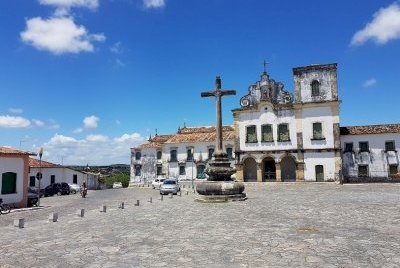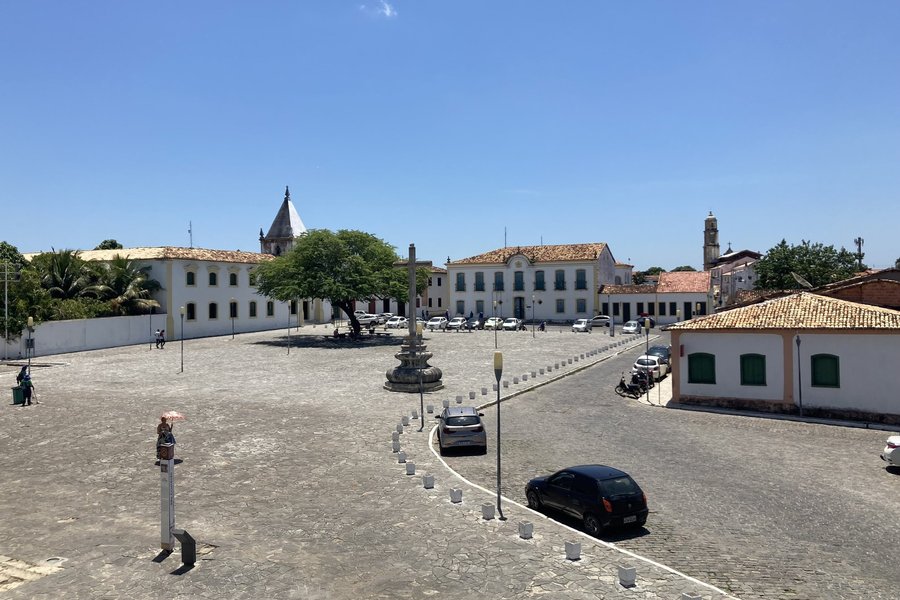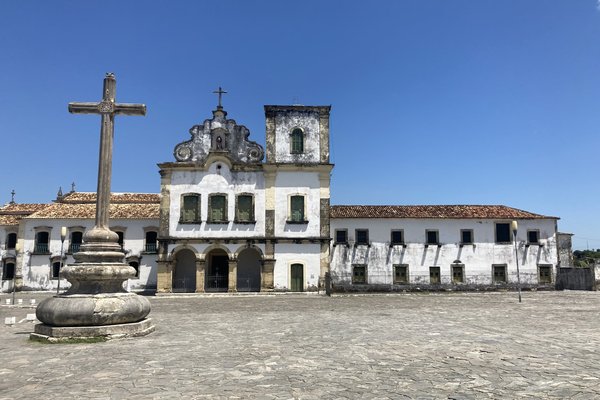Brazil
São Francisco Square
São Francisco Square in the town of São Cristovão is an open space surrounded by a monumental architectural ensemble.
It combines the urban planning ideas of Portugal and Spain, as the square originates from a time when Portugal and Spain were under the same crown. The concept of a Plaza Mayor was taken from Spanish colonial cities. The most prominent monuments around the square are São Francisco Church and Convent (begun in 1693), Church and Santa Casa de Misericordia (18th century), and the Provincial Palace.
Community Perspective: Due to its Spanish roots it’s unique in Brazil, but that’s about it and there is little tourist infrastructure. Best reached from the coastal city of Aracaju.
Site Info
Official Information
- Full Name
- São Francisco Square in the Town of São Cristóvão (ID: 1272)
- Country
- Brazil
- Status
-
Inscribed 2010
Site history
History of São Francisco Square
- 2010: Advisory Body overruled
- ICOMOS advised Deferral: "Reconsider the proposed boundaries of the nominated property in order to include other sectors of the São Cristóvão historic centre "
- 2010: Inscribed
- Inscribed
- 2008: Referred
- boundaries, conservation management
- 2008: Revision
- Reduced from former TWHS Les couvents franciscains du nord-est brasilien (1996)
- Type
- Cultural
- Criteria
- ii
- iv
Links
- UNESCO
- whc.unesco.org
- Official
-
- saocristovao.se.gov.br — Municipal page of Sao Cristovao
All Links
UNESCO.org
- whc.unesco.org — whc.unesco.org/
Official Website
- saocristovao.se.gov.br — Municipal page of Sao Cristovao
Community Information
- Community Category
- Urban landscape: Latin American
Travel Information
Recent Connections
-
Shoe covers required
In the Sacred Art Museum (part of the F… -
Built or owned by Spanish
"Since the town of São Cristóvão was fo… -
Reduced from broader TWHS
TWHS was originally a serial nomination…
Connections of São Francisco Square
- Trivia
-
-
Built or owned by Spanish
"Since the town of São Cristóvão was founded during the period when Spain and Portugal were ruled by the same Crown, Spanish codes for urban patterns were employed, especially the use of a regular grid" (AB ev) -
Built or owned by Portuguese
"it demonstrates the occupation processes of the region and the development of towns founded during the reign of King Philip II, during the 60-year period when Portugal was under Spanish domain" (AB ev)
-
- History
-
-
Fusion
Criterion (ii): The Sao Francisco Square represents the outcome of the merging of the modes of territorial occupation and settlement of Portugal and Spain according to which urban settlements were established in their respective colonial empires. This property exhibits an important fusion of urban models, which occurred during the unification under one crown of two rival Empires.
-
- Architecture
-
-
Baroque
Church and Santa Casa da Misericordia: "baroque ornamentation" (AB ev)
-
- World Heritage Process
-
-
WHC locations
Brasilia (2010) -
Reduced from broader TWHS
TWHS was originally a serial nomination of the Franciscan convents of North-East Brasil. After a deferral in 2008 the TWHS was reduced to Sao Cristovao alone.
-
- Religion and Belief
-
-
Franciscan Order
"The Franciscan complex is an example of the typical architecture of the religious order developed in north-eastern Brazil" (unesco website)
-
- Timeline
-
-
Built in the 17th century
"As early as 1615, when the French had been driven out, the Chief Engineer of the State of Brazil,......(drew) up plans for new defences of the liberated town. In addition, he prepared an urban plan, .... as the guide to its expansion and development. It was based on geometric regularity ..... in contrast to the medieval layout of narrow winding streets applied by the Portuguese in Rio de Janeiro, Recife, and Olinda. It was to serve as the basis for the expansion ....By the end of the 17th century Sâo Luis bad a population of some ten thousand," (AB)
-
- Visiting conditions
-
-
Shoe covers required
In the Sacred Art Museum (part of the Franciscan church-convent complex), because of the original wooden floors on the upper level.
-
News
No news.
Recent Visitors
Visitors of São Francisco Square
- Adrian Turtschi
- Alejandro Lau
- Alexander Lehmann
- Ammon Watkins
- Atila Ege
- Carlos Sotelo
- Chinmaya
- Cirene Moraes
- Els Slots
- Erik Jelinek
- Fan Yibo
- Iain Jackson
- João Aender
- Jon Opol
- Luis Filipe Gaspar
- lynnz317@aol.com
- Michael Ayers
- Michael Novins
- Nihal Ege
- Patrik
- Reza
- Roman Bruehwiler
- sibariam
- Thomas Buechler
- Thomas van der Walt
- Wojciech Fedoruk
- Zoë Sheng
Community Reviews
Show full reviews
Site visited in December 2020. Before São Cristóvão we visited 12 WHS in Brazil and they were all worth a visit. Although the Brazilian list can be accused of overloading with colonial towns, selected examples (Ouro Preto, Diamantina, Goias) were certainly outstanding in their category. However, the visit to São Cristóvão left a great dissatisfaction. The town is not particularly distinguished, the historical center is small and rather overlooked by tourists. São Francisco Square itself makes a nice impression, but it is definitely hard to notice the 'outstanding universal value' of this place. It was even harder for us, because both churches entered and the Provincial Palace were closed due to the pandemic.
The negative experience was somewhat sweetened while walking around the historic center and visiting the Igreja Matriz de Nossa Senhora da Vitória open church. It seems that according to ICOMOS, adding the historic center to this entry would make more sense than listing the square itself. But even in that case, it would be by far the worst place on the Brazilian UNESCO list. Fortunately, the visit to São Cristóvão did not require us to deviate too much from our route from Serra da Capivara to Salvador. It took us maybe an hour to explore the town, the other hour to a delicious and very cheap lunch in a local bar, and 4 hours later we checked into the historic center of Salvador.
Keep reading 0 comments
Sao Francisco square in Sao Cristovao was not much more than a typical square for the area. We weren't even sure we were in the right place but finally found a UNESCO sign on a nearby building. Surprisingly there is a lack of preservation in the surrounding streets though there are a couple of older churches. In all we spent maybe 1.5 hrs there.
it feels like they don't know what they have there. There wasn't any tourist infrastructure at all. We visited late morning mid week. We were the only obvious tourists, foreign or domestic, there were school kids running around the neighbouring streets and everything was closed, including the little tourist info office. It felt safer and cleaner than I expected given the state of northeast Brazil these days but there arent any of the quaint guesthouses or little restaurants catering to visitors you expect to see around a WHS these days.
The easiest way to visit is a side trip from Aracaju, a pretty standard coastal city with plenty of accomodation options. There is a local bus leaving from the old central bus station quite regularly and takes less than an hour. We actually caught an Uber there and took the bus back. For us it was a logical stop as we worked our way down the coast from Olinda to Salvador but unless you are in the area and have time to kill it has nothing to add to the experience of visiting those …
Keep reading 0 comments
São Francisco Square is located in São Cristóvão, a small town close to the capital of the State of Sergipe - Aracaju. It is rather an ordinary square, like so many others in Northeastern Brazil, with a simple church and a religious museum on its side. What UNESCO suggested to be extraordinary is that the square was designed in 1590 according to Spanish Ordinations, something unique in Brazil and it was to the fact that, at that time, the Portuguese and the Spanish Crowns were united under Philip II. There's a couple of other 17-Century churches nearby and a humble museum of the State of Sergipe - São Cristóvão was its first capital, and nothing more. It is difficult to understand why UNESCO chose this city to have the same status of Olinda, Salvador or Ouro Preto, majestic colonial cities. If you really want to collect this WHS, Aracaju is well served with internal flights and, by land, is not far away from Salvador.
Keep reading 0 comments
